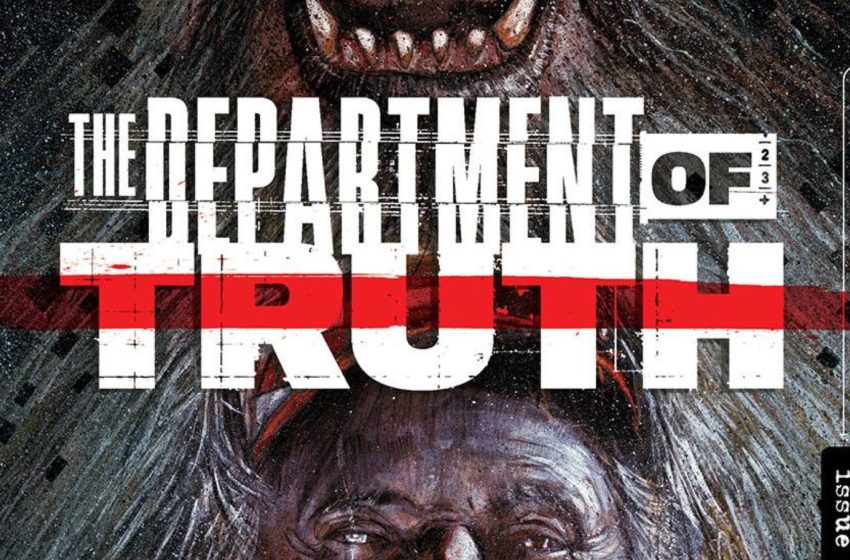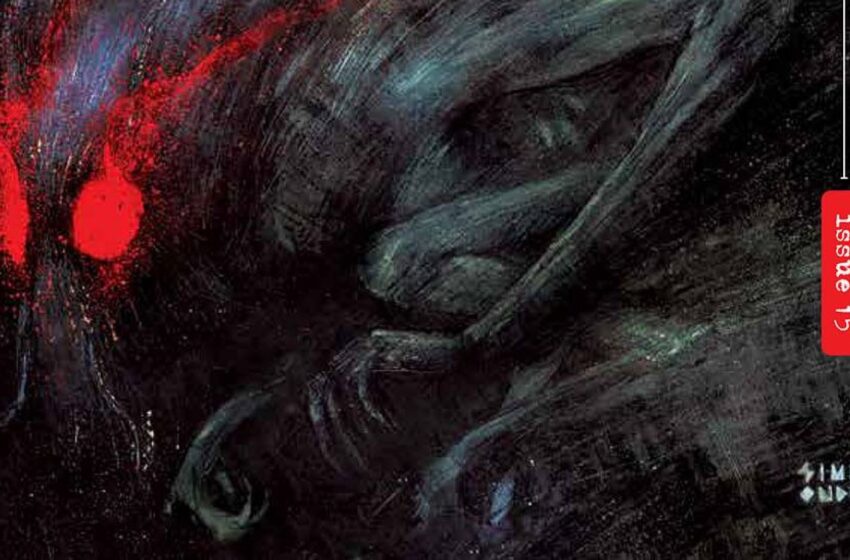It’s time to go hunting in Department of Truth #10 by writer James Tynion IV, artist Martin Simmonds, letterer Aditya Bidikar, designer Dylan Todd and editor Steve Foxe.
Will Nevin: Forrest, let’s start with something that’s weird to me: How come I didn’t understand the series’ references to date regarding tulpas, considering that’s the central premise of the whole damn book? How would you define them? And also, am I stupid? Thanks, I’ll hang up and listen.
Forrest Hollingsworth: Given the relative cultural-appropriation significance of Tulpas, similar to the Kabbalah Tree of Life, in some circles I’m inclined to give you a pass — sometimes not knowing things is good! In short, though, the conceptualization of Tulpas comes from Tibetan Buddisht thought and is shorthand for a mental, emotional or spiritually willed manifestation. Sprul-Pa, thoughtform and imaginary friend serve the same purpose. Notably, and of relevance to this issue in particular, some are formed with autonomy, and some without. If you’re like me, though, you know them from being deep into Twin Peaks lore. Did you hang up? Wait, did he say he was hanging up before I started talking?
Will: It’s a bit that Boss Man Dan likes. Take it up with him. [Grote’s note: HEY!] With that out of the way, let me hit you with another question: Do you believe in cryptids? To me, it seems like one of those gateway rabbit holes like the Kennedy assassination; it’s just believable enough to trick someone who’s not versed in science and also not good at thinking critically. The fact that we haven’t discovered every single species living on the planet — and that we’re finding new creatures in the fossil record all the relative time — suggests that something could be out there and waiting to make someone famous. Some dangerous shit, for sure.
Forrest: I think I lean a little more toward believing than you do — I have mentioned my fondness for Keel’s “Ultraterrestrial” idea before, and I think other dimensions in particular are an underserved branch of science that opens a lot of opportunities for the unexplained that we don’t have time to explore here — but I also take the notably boring position of “If they existed in the form people think of them as, they’re probably extinct” for stuff like Bigfoot, Thunderbirds, the Loveland Frogman, etc.
Will: I guess one of us has to be Scully, right?
[Grote’s note: Does that make me Skinner?]
The Human Cost of Living in Your Own Reality

Will: Issue #10 was probably one of my favorite Truth drops so far, primarily because it employed the same in-universe flavor text approach we saw in Nice House on the Lake. (Which has a new issue of its own, and I Can. Not. Wait. To. Cover. It. With. You. Shortly.) In Nice House, Tynion mixes in emails to build out that world, but here, it’s a diary from a man whose existence has been consumed by the hunt for Bigfoot just as his father’s life was destroyed by the very same thing.
I like the prose — as I’ve said before, I’ll read any paragraph in a comic so long as it’s not something Brian Michael Bendis is trying to pull off in 17 different word balloons — but I’m of two minds on the underlying substance: I like this story as an illustration of what happens when your brain gets swallowed up by bullshit, but also, wouldn’t it have been more powerful if this approach had been taken with QAnon (a real world example of how conspiratorial beliefs can fracture families) rather than something like Bigfoot?
Forrest: I think the simple fact is that QAnon is more draining to think about compared to something a bit more silly, like Bigfoot. Have you seen the episode of The X-Files where Mulder gets a picture of a female Bigfoot with big tiddies? Objectively hilarious. There’s a narrative balance that I think Tynion is treating keenly, but I’ll take the contrarian stance and say that I didn’t particularly like the prose here! In Nice House On The Lake, the intent is to use diegetic media to tell us about the interconnectedness of the world, and even more narrowly about the 24/7 news cycle in its final moments: social media, emails, ads — they’re important signifiers of the exchange of information, and central to the character’s lives and routines. But an albeit touching, haunting letter about Bigfoot doesn’t have the same effect.
There’s nothing about the letter as an object that is essential to the story of the hunter or his family’s obsession with Bigfoot, and it doesn’t convey any more meaning or significance than a flashback sequence or a tense phone call — which Tynion also uses here — would. I would’ve rather seen the art used to better effect here.
Will: I will never not enjoy flavor text. But I get your point. Also, I haven’t seen that episode, but it sounds hilarious.
On the Hunt

Will: The most famous Bigfoot sighting is, of course, a hoax, but at least it’s one with a fascinating history to it. Forrest, I wonder — why do you think this imaginary creature has such a hold on pop culture? It’s this guy and the Loch Ness Monster, and I’m not even sure of any other cryptid that gets in that conversation as to the elite, imaginary beasts of the world.
Forrest: Let’s not discount Mothman! He’s having a hot-boy moment. But I digress, I guess it’s just the potential thrill of seeing something unnatural in your day-to-day life, right? Bigfoot, Nessie, Mothman — they have a proximity to culture and civilization that other things like aliens abstract. It’s the appeal of having secret knowledge or a secret encounter. I realize I’m explaining it like it’s an affair, but it kind of is! Millions of people can’t stop themselves from saying “Look, horses” every time they drive past a field as is; who knows how special you would feel if it was a frogman only a dozen people have seen.
Will: One of the more interesting developments in this issue — at least when it comes to learning more about the Department — is that it has a whole branch devoted to cryptids. Tynion — through our favorite (or not so favorite) asshole, Hawk Harrison — explains why they pose such a problem. Did you buy that argument? To me, it seemed a little thin in a world with, again, QAnon and other conspiracies that can so easily come to dominate a person’s life.
Forrest: I disagree. I was in the Something Awful forum where Slender Man was created, and I watched with horror as it went from internet myth to cultural touchstone, to the inspiration for a pre-teen stabbing in 2014. I think the point is that something as silly as photoshops of a mannequin man in a suit, given enough attention, can become a catalyst for change both on a big scale and in individual lives. What’s the ideological difference or proximity between something like that and a school shooting, something the book has explored before?
A legend is a deeply powerful thing, the temptation of becoming legendary yourself even more so, and I understand why the Department would be interested in that on the axis of cryptids, creepypastas, SCPs, NoSleeps, etc. for their memetic properties as much as they would be something like QAnon.
Into the Forest We Go

Forrest: Sorry, into the what? Oh, OK, carry on.
Will: ZING! But, yes, we end this issue on something of a cliffhanger, with Cole, Hawk and one of the Department’s cryptid specialists traipsing off into the woods in advance of a likely showdown with the aforementioned poor bastard suffering for more than a generation on account of his brain worms. What do you think of devoting so much time to Bigfoot in this arc, and where do you see the story going from here?
Forrest: The problem for Cole, and us, is obviously the nonchalant way that people like Hawk talk about taking a believer’s life. There’s a narrative thread of the Department doing things simply because they’ve always been that way, trapped in patterns of their own, that I’m interested in seeing explored further. I also hope we get to see that big stinky ape’s thang if you know what I mean.
Will: I’m surrounded by monsterfuckers. God bless you and your chaotic energy.
An Eye for an Eye, A Truth for a Truth
- Does Hawk have a bullseye tattooed on his face or is it a symbol of Cole’s increasing frustration with him?







